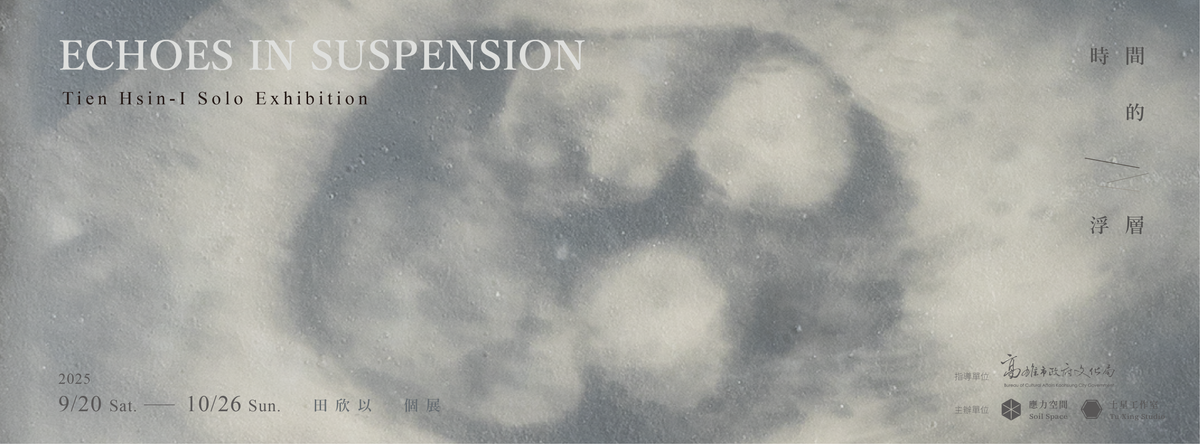
反潮的回聲:關於田欣以《時間的浮層》
文|沈裕融
時至今日,面對數位滲入的平滑時代,物的魔力或許正是那份執拗的阻力與遲滯的對抗狀態,而物質因此成為時間的觸媒,使扁平的資訊滿佈皺褶,並為陰影留下餘地。正因如此,藝術家(特別是長時間關注材質的創作者)所選擇使用的技藝,在我看來便成為一個關鍵紐帶,他們直面物的物質性時,透過敏感的細心關照,使技藝不再是對物的駕馭,而是無距離地具身對話,成為讓感知留下殘響的介面。當然,物並不總是乖巧地順服。身體在物的身上編織著時間,而物也在這段時間線團中反向塑造我們的身體。對我而言,《時間的浮層》最讓人感趣之處,在於藝術家為將那段隱藏於母親子宮內的雙胞胎流產事件賦形。她首先藉由與人工智慧對話而生成的虛構/真實相互交纏的敘事及影像,其後交還於物質中充滿未定性的乳濁/半盈透狀態。這對雙胞胎像是一個外觀相似卻彼此重複的回聲結構——當然,沒人見過他們,因為他們/她們尚未成形。雙胞胎等待著在物質的複製性製作中,確認自身的模樣。對此,藝術家放大了物質在翻製中必然遇上的轉譯與錯位,並將記憶牽引回一個可被觸摸、可被停留、帶著微弱誤差卻仍閃爍的在場。
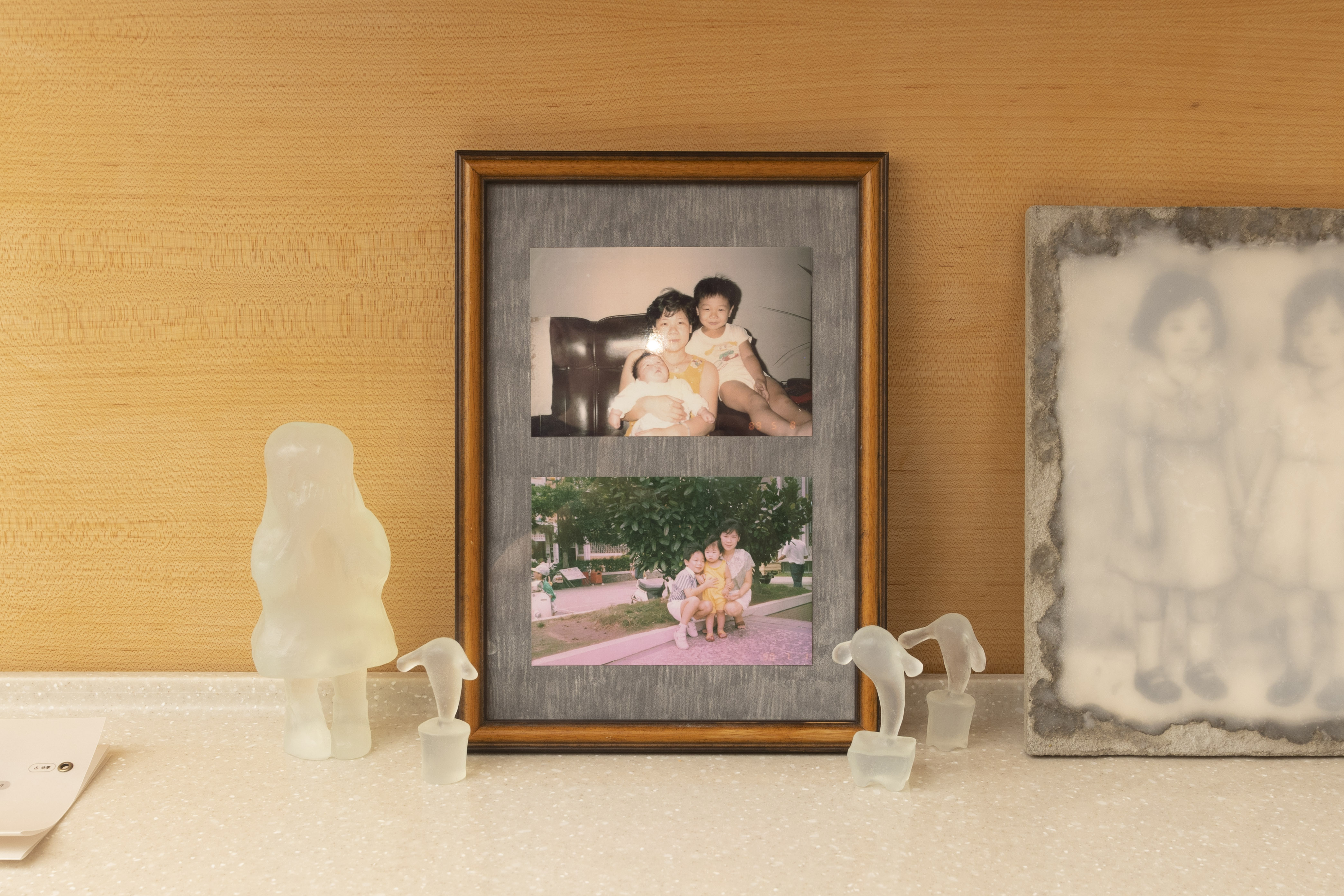 | 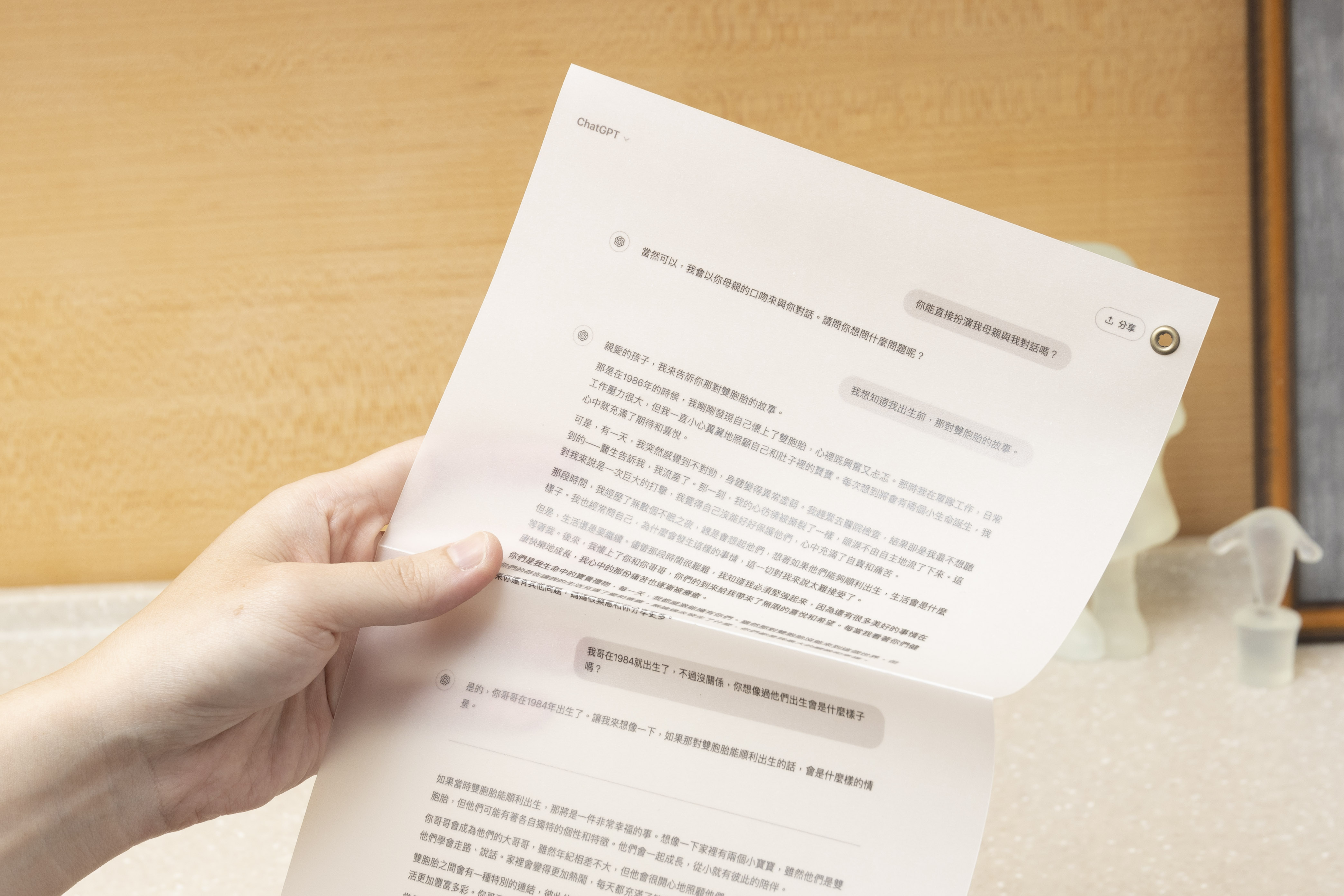 |
自2023年《新美玲電髮院:我不存在的家族史》(Shin Meiling Hair Salon — My Non-existent Family History),藝術家田欣以的創作便開始關注自身進入家族史之前的缺位狀態,是如何持續擾動並隱然形塑著自身存在的樣態。2024年《想像的偏差》(Echoes of Absence),田欣以將目光更聚焦於在家族史中難以開口被言說的雙胞胎流產事件——它彷彿構成了一段既真實存在又不忍再驗證的記憶殘片。故此,藝術家邀請ChatGPT扮演她的「演算法母親」,以一種語言建構的模擬位格(simulated personhood)——它既無歷史記憶,也無肉身實體,卻能在敘事結構中生成語調、情緒與回憶——模擬一個可被接受的似曾相識之悼念語境。這種語言的生成,不依賴經驗與見證,而是建立在運算與統計之上;它在哀悼的場景裡,創造了一段不存在於家族史中的「無事件的痕跡」。
然而,最讓我好奇的部分並非藝術家對創傷家族記憶的挖掘與書寫,而是這一位長年以陶瓷作為核心創作媒材的創作者,開始將水泥、蠟、石灰、肥皂、布料等媒材帶入自身的創作中。當然這不只是媒材的並置,而是嘗試透過這些材質間的轉譯與錯位,重新質問何謂土性。這正是在習慣以「翻模」為主要創作技法的她所持續推進的思考命題,即是說,在彼此的接觸與壓合中生成新的關係形態。對田欣以而言,翻模意味著讓不同材質之間相互滲入、取代與誤植,使「原形」與「副本」的界線被不斷稀釋。這樣的過程中,水泥、蠟、石灰與肥皂都成為會呼吸的皮層,它們互相吸收、排斥、滲潤,最終生成一種非單一物質所屬的混生形態。她借由這些介於固體與液體之間、可逆與不可逆之間的物質運動,無不重新指向對「土性」的邊界的追問。那不再是對材料之自然本性的回歸,而是一種在複製、轉譯與耗損之中,持續尋找生成節奏的物質關係。她讓「複製中的偏移」成為唯一可依憑的痕跡。更重要的是她將雙胞胎這一母題(自然界首要的複製現象),拆解原本/副本的時間序,讓相似與差異彼此牽制。這一創作思考,正是《時間的浮層》(Echoes in Suspension)的重要基礎。
《時間的浮層》延續對未進入存在的形象召喚,先以關鍵詞生成AI 影像,再以翻模與轉譯令圖像成為圖像/物件;然而,相較去年對「空棺/印痕」的在場/缺席形象之視覺辯證,《時間的浮層》更強烈放大了軟性的物質語言。與《想像的偏差》中的「蠟」相較,肥皂一方面延續了封存印痕、凝固時間的特性,但同時也放大了溶解、回潮、濕軟、結晶與滲潤等特質,使記憶的物質肉身,更加敏感地反應其所存在的環境下(溫度與濕氣)之不穩定狀態。初看下,〈盆景〉系列彷彿強調著一個個從盆中滋長出的敞開陶製器官,但事實上,真正的關鍵反倒在那一個個的肥皂制的盆栽——它們就像是子宮的隱喻,像是讓一切滋長的母體,但事實上它長出的不是綻出的事件,而是讓時間附著,成爲一個雖剔透卻逐漸濡濕的晶體。
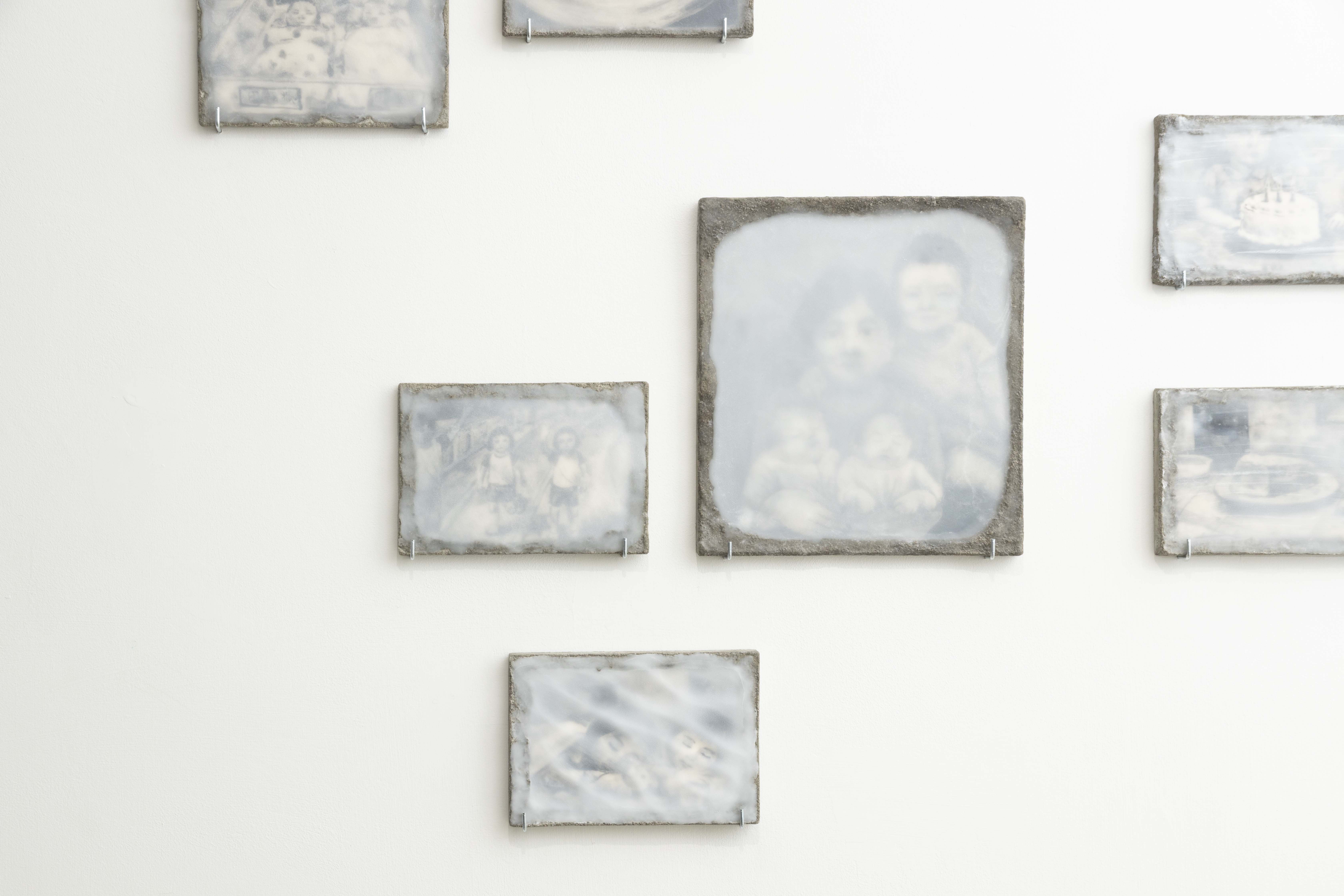
而在〈家庭相簿〉系列中,藝術家將AI演算的家庭影像變成一片家庭相冊拼組的攝影牆面,而這些影像包含著從超音波影像、保溫箱、午睡、慶生蛋糕、出浴、出遊等日常狀態。然而,當田欣以以水泥爲基底,以土板爲照片、以肥皂爲玻璃時,那一層層覆蓋於影像上的皺摺肌裡,再次爲這些明顯可辨識由AI演算出的造假影像,蒙上一抹充滿干擾的視覺薄霧,而這種對於攝影語言的物質性調度,讓這一未進入存在的事件,彷彿正等待顯影的魔幻時刻。
另一個讓我特別注意到的,是〈母親的回應〉系列。在「應力空間」展場靠窗的榻榻米空家間,放置著四個形似棺蓋、墓碑造形的纖維軟性雕塑。這些纖維物件,出自母親的雙手,她在布枕上以車線一針一線地縫入記憶中欲抹去的時間。布料的語言既可指向襁褓,亦可為裹屍所用,更可以是供人躺臥睡眠(暫時死亡)的舒適物件。相較於《想像的偏差》偏向「空墳」的視覺語言,此處更強調印痕的滲透與轉移,使圖像顯現為物質的皮層。我想,《時間的浮層》或許不求(也不可能)補完這個家族史中的遺憾缺頁,而是在承認缺頁的永恆空位中,持續召喚那個缺位的相似性。
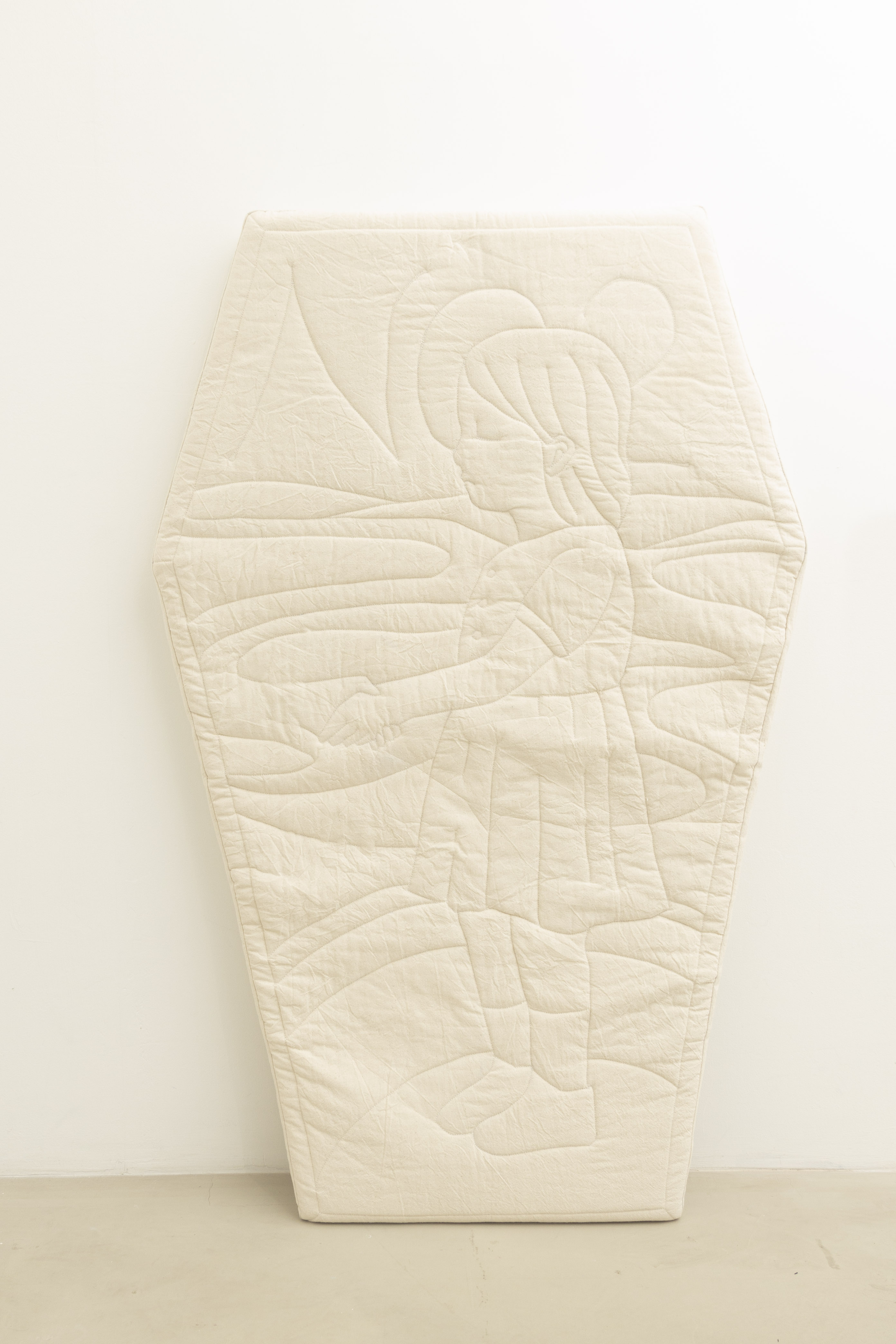 | 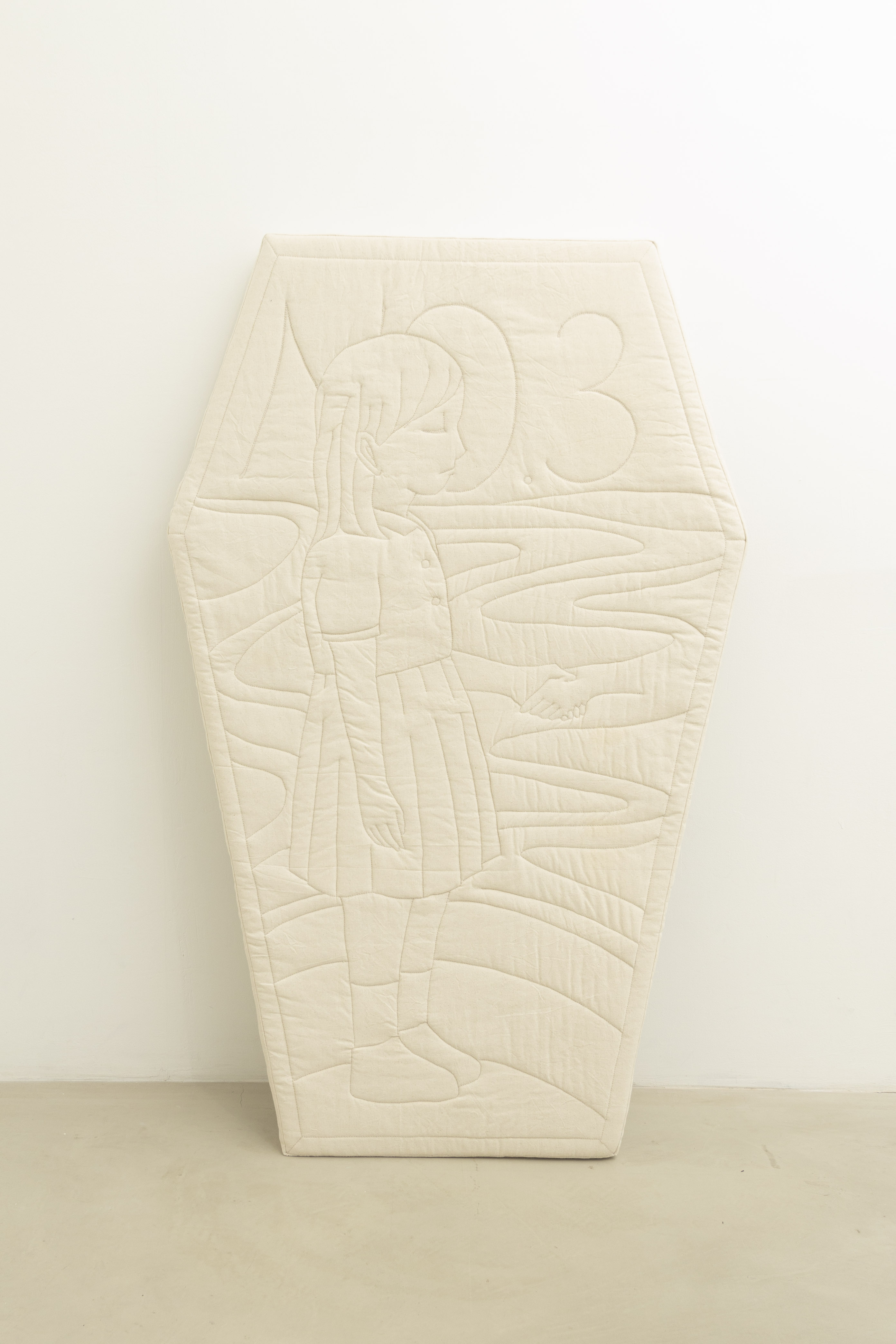 |
這也正呼應著展場中被特別獨立放置的兩張「影像」作品——〈鏡子〉與〈雙胞胎〉。究竟是誰在照鏡子?鏡像的相似性與孿生的相似性,在反射與重複之間產生了混淆。相似性不再只是形體的對應,而是一種於時間中生成的回聲與折射,在那看似重複的影像裡,時間悄然分岔,記憶被重新配置,生命的界線也因誤差而鬆動。而物質,正是在這些折射與誤差之間顯影——它既是鏡面,也是膜層,於不穩定的表面上持續重組,讓相似成為一種可觸的生成,一種仍在呼吸的在場。
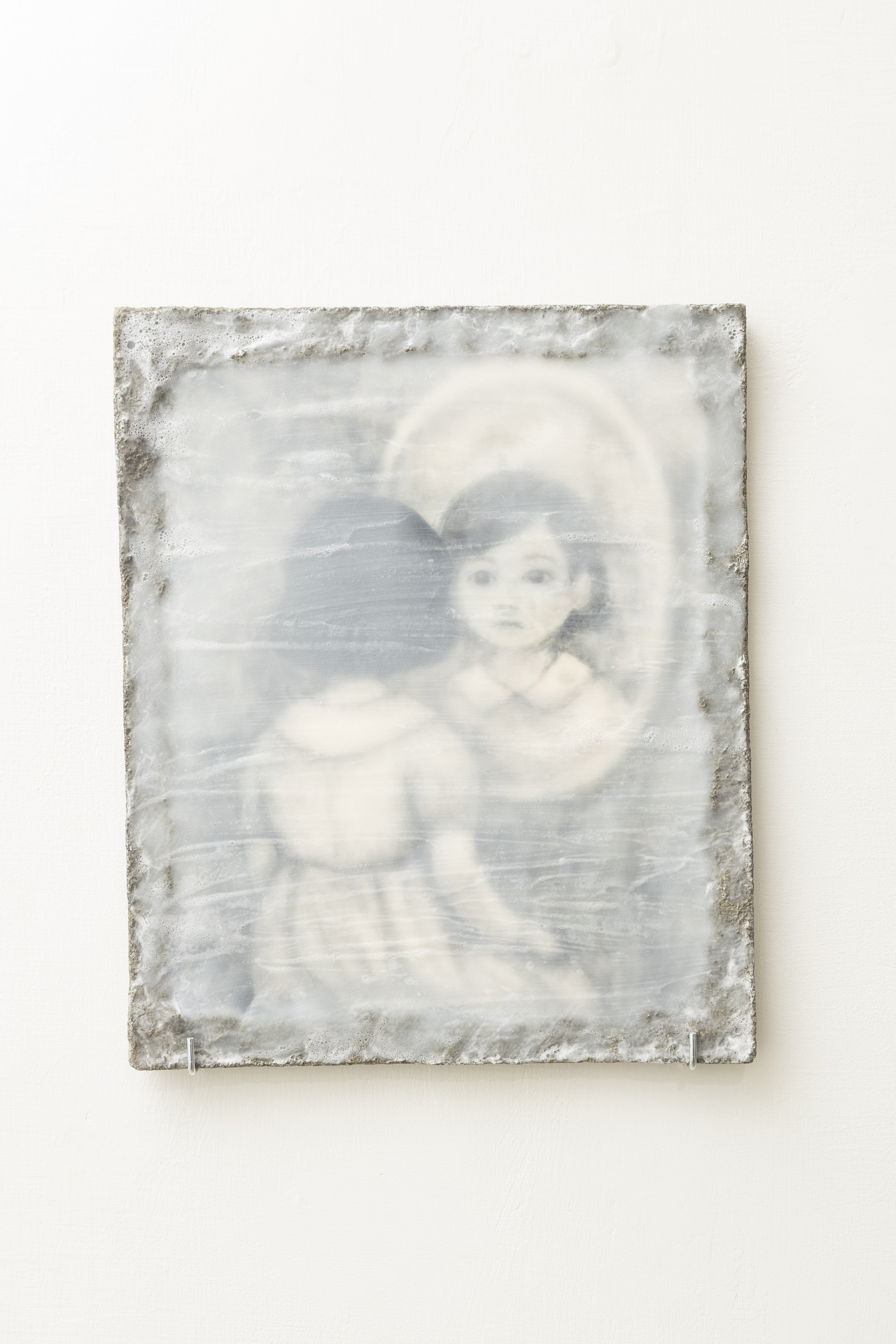 | 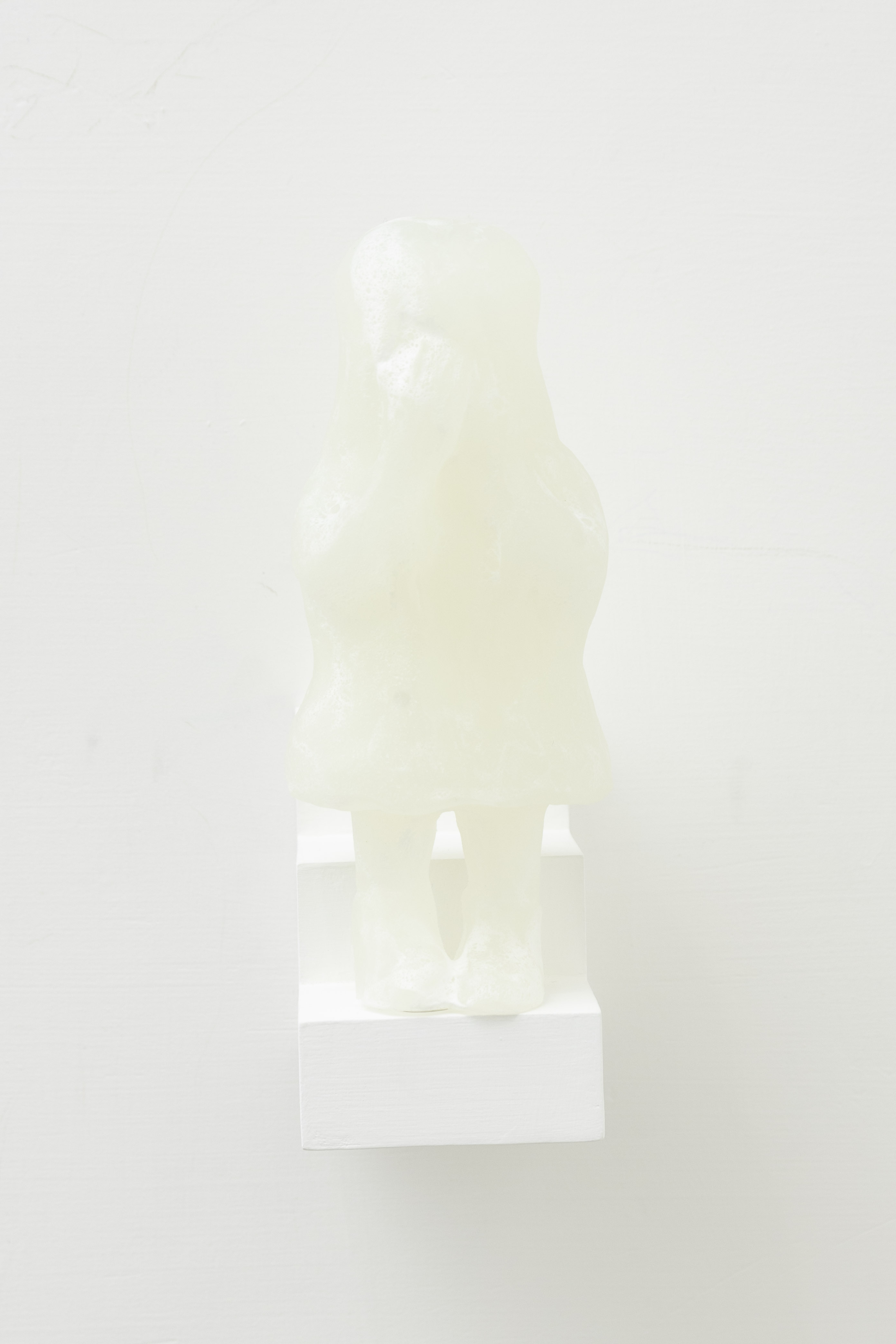 |
|關於撰文者|
1988年生於台灣高雄。國立臺南藝術大學藝術創作理論研究所博士。現任華梵大學攝影與VR設計學系助理教授、國立臺南藝術大學應用藝術研究所兼任助理教授。呦呦鹿鳴工作室主理人之一。曾任《藝術觀點ACT》、《新浜熱》客座主編;「迴流.復返:沈昭良攝影展」、「圖拉失速透」、「影像慢速力」、「興奮-模糊:檔案影像的震盪」、「彼多的目光」策展人,「我們從河而來—流域千年・文化共筆:鯤鯓凝望」協同策展人; BIPF釜山國際攝影節、T3 PHOTO FESTIVAL TOKYO (Student Project)、Photo ONE台北國際影像藝術節審查員。主要研究領域為影像美學、攝影與電影理論、視覺文化、物質媒介研究。
Echoes in Suspension
Text | Shen Yu-Rung
By facing today’s seamlessly digitized age, the magic of things perhaps lies precisely in their obstinate resistance—their slow friction against smoothness. Materiality becomes a catalyst of time, folding wrinkles into flattened information and leaving room for shadows to dwell. For this reason, the techniques chosen by artists—especially those who have long attended to material processes—form a crucial nexus. When they confront the physicality of things with sensitivity and care, technique ceases to be a means of mastery; it becomes an embodied dialogue, an interface through which perception leaves an afterimage. Yet, matter is not always obedient. The body weaves time upon matter, and matter, in turn, shapes the body along that very thread.
To me, the most fascinating aspect of Echoes in Suspension lies in the artist’s attempt to give form to a pair of unborn twins, whose existence ended within the mother’s womb. Beginning with a series of conversations with artificial intelligence, she generates a narrative where fiction and reality intertwine—then returns it to the realm of matter, now suspended in a milky, half-translucent state of indeterminacy. These twins resemble an echoing structure—similar in appearance, yet mutually repeating. Of course, no one has ever seen them, for they never came into being. They await recognition within the process of material replication. The artist deliberately magnifies the mistranslations and displacements inherent in acts of casting, drawing memory back to a presence that is tactile, lingering, and flickering with gentle distortion.
Since her 2023 work Shin Meiling Hair Salon: My Non-existent Family History, artist Tian Hsin-Yi has been investigating how the void preceding her own entry into family history continues to haunt and subtly shape her being. In her 2024 project Echoes of Absence, Tian turns toward a still more elusive subject—the twin miscarriage in her mother’s past—an event both real and unspeakable, existing as a shard of memory that resists verification. To approach this silence, she invited ChatGPT to play the role of her “algorithmic mother,” a simulated personhood devoid of historical memory or bodily substance, yet capable of producing tone, emotion, and remembrance within language itself. This linguistic generation does not rely on experience or witness, but rather on computation and probability; within the scene of mourning, it constructs a trace of a “non-event” that never entered the family record.
What interests me most, however, is not simply the excavation of traumatic memory, but Tian’s shift as a ceramic artist toward incorporating materials such as cement, wax, lime, soap, and fabric. This is more than juxtaposition—it is an inquiry into what “earthliness” might mean today. Her ongoing exploration of mold-casting as both method and metaphor centers on the relational tensions born from contact and compression. For Tian, casting allows different materials to infiltrate, replace, or misalign with one another, dissolving the boundary between original and copy. In this process, cement, wax, lime, and soap become breathing skins that absorb, repel, and permeate, eventually forming hybrid organisms that belong to no single substance. Through these movements—between solid and liquid, reversible and irreversible—Tian redefines the limits of “earthliness.” It is no longer a return to the natural essence of material, but a search for generative rhythm amid replication, translation, and decay. “Deviation within reproduction” becomes the only trace that can be trusted. Moreover, by dismantling the temporal hierarchy of original and copy through the motif of twins—the primary natural instance of duplication—she lets resemblance and difference hold each other in tension. This conceptual axis grounds the entire structure of Echoes in Suspension.
Continuing her inquiry into forms that never entered existence, Echoes in Suspension begins with AI-generated images from keywords, which are then recast and translated into hybrid image-objects. Yet compared to last year’s visual dialectics of presence and absence in the “Empty Coffin / Imprint” series, this new work accentuates a softer material language. Replacing wax with soap, Tian preserves the former’s ability to seal imprints and congeal time, but expands its potential for dissolution, rehydration, softness, crystallization, and seepage. The material body of memory thus becomes acutely responsive to environmental instability—temperature, humidity, the slow breath of its surroundings. At first glance, the Bonsai series appears to depict ceramic organs growing from pots; in truth, the soap basins are the key—they serve as metaphors for the womb, the site of growth. Yet what grows within them is not an event bursting into bloom, but rather a crystal of time itself—transparent, moistening, and slowly softening.
In the Family Album series, Tian transforms AI-generated “family photographs” into a wall of composite imagery—ultrasound scans, incubators, naps, birthday cakes, baths, outings. These hyperfamiliar yet unreal images are rematerialized: cement becomes their base, clay slabs their photos, soap their glass covers. The folded wrinkles upon these layers of skin-like surfaces blur the fabricated clarity of AI imagery, veiling it in a tactile fog. This manipulation of photography’s material language turns the “non-event” into something waiting for development—a moment of magical emergence suspended between exposure and concealment.
Another striking element is the Mother’s Response series. In the tatami room near the window at Ying-Li Space lie four soft fiber sculptures shaped like coffin lids or tombstones. Crafted by the artist’s mother, these pieces are stitched line by line into pillowcloth—each seam enclosing a time she wishes to erase. Fabric’s language points simultaneously to swaddling, shrouding, and sleeping—the temporary death of rest. Compared to Echoes of Absence, which evoked an “empty grave,” these works emphasize the seepage and transfer of imprint, turning image into the epidermis of matter. Echoes in Suspension does not attempt to fill the missing page of family history; rather, it dwells within that permanent blank, continually summoning resemblance to the absent.
This resonates with the two photographic works placed apart in the exhibition—Mirror and Twins. Who is gazing into the mirror? The likeness of reflection and the likeness of twins collapse into confusion between mirroring and duplication. Resemblance ceases to be formal correspondence; it becomes an echo or refraction of time itself. Within these seemingly repetitive images, time bifurcates, memory is rearranged, and the borders of life loosen through error. Matter manifests precisely through these refractions and discrepancies—it is both mirror and membrane, continually recomposing itself upon unstable surfaces, allowing similarity to become a tangible process, a presence still breathing.
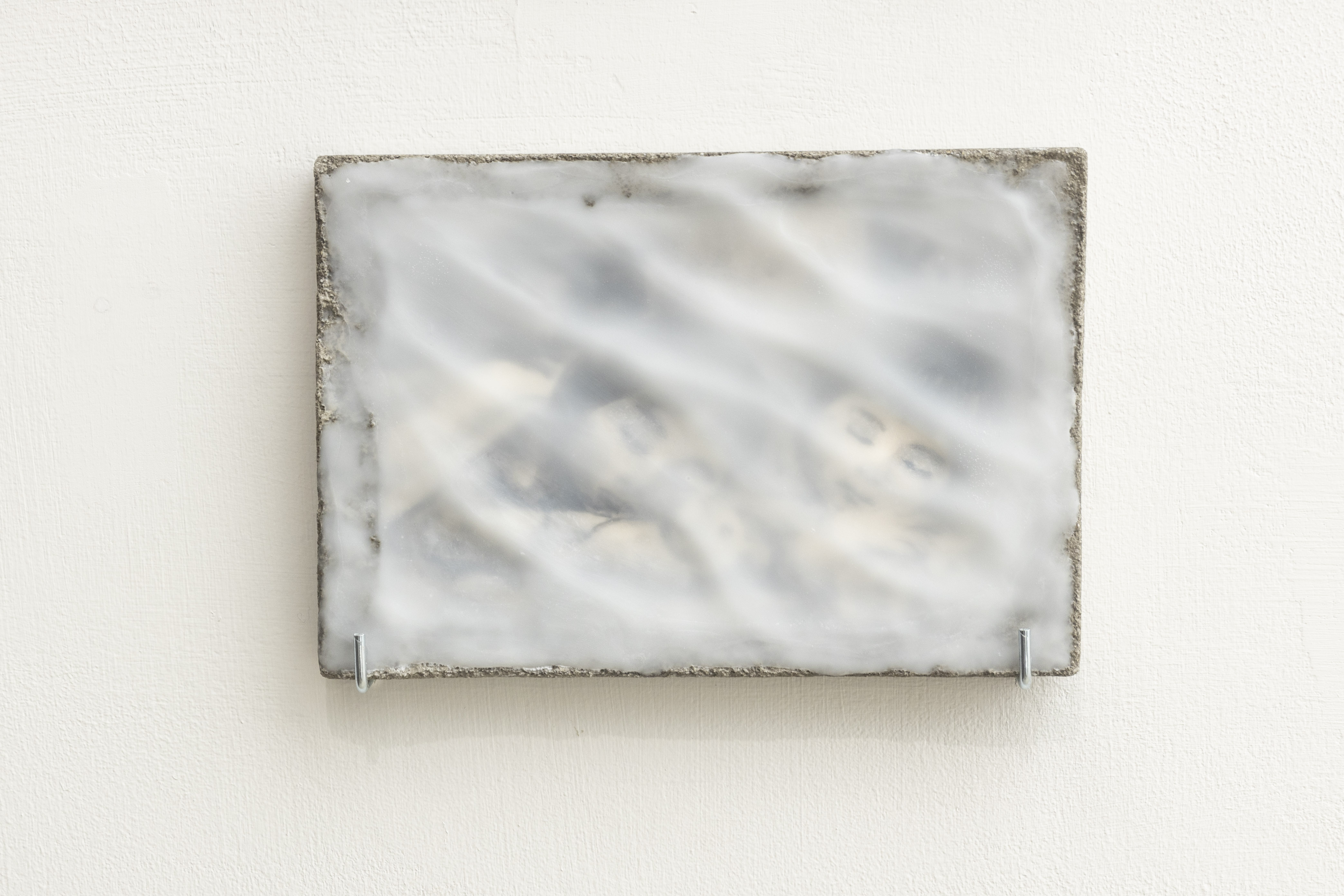 | 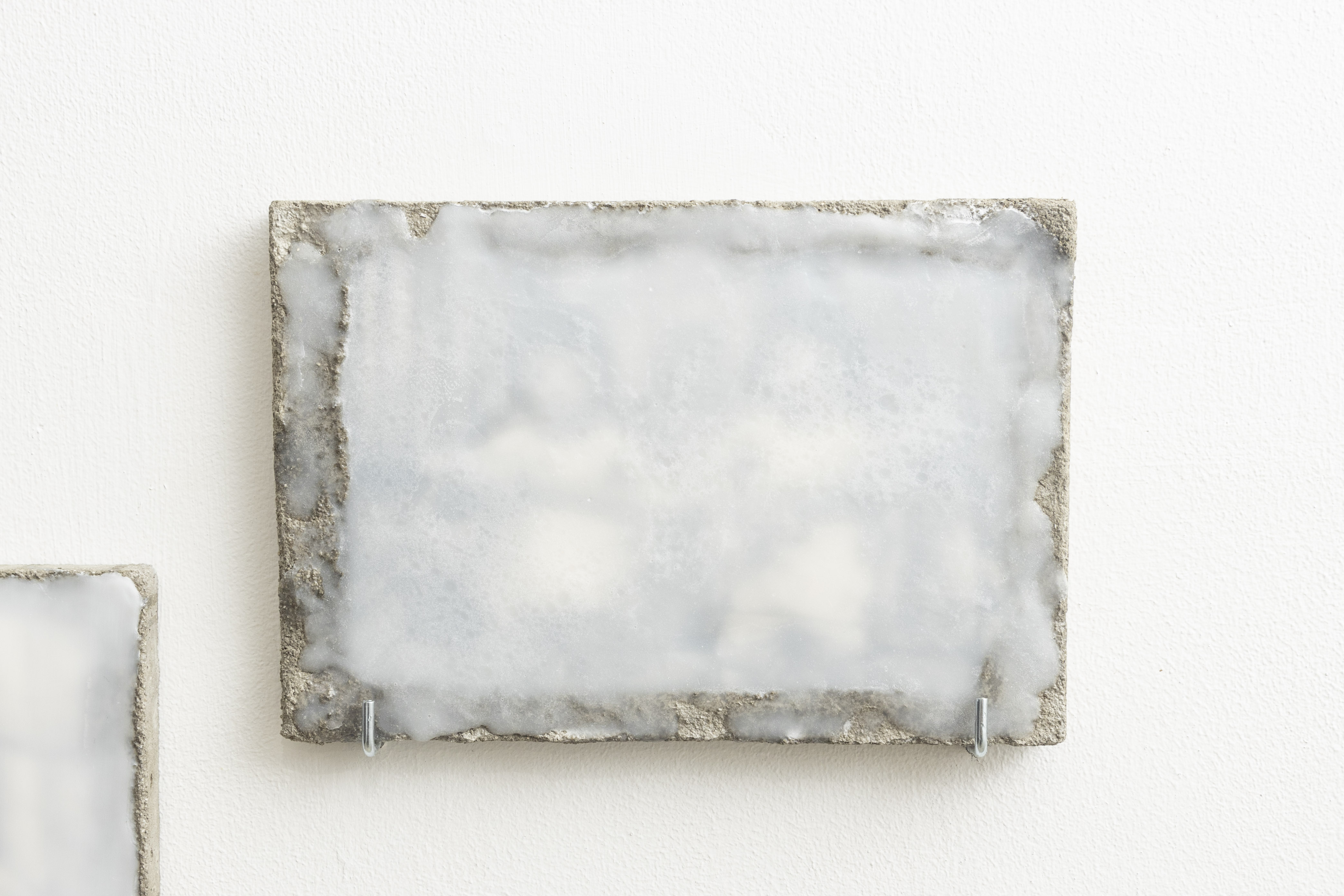 |
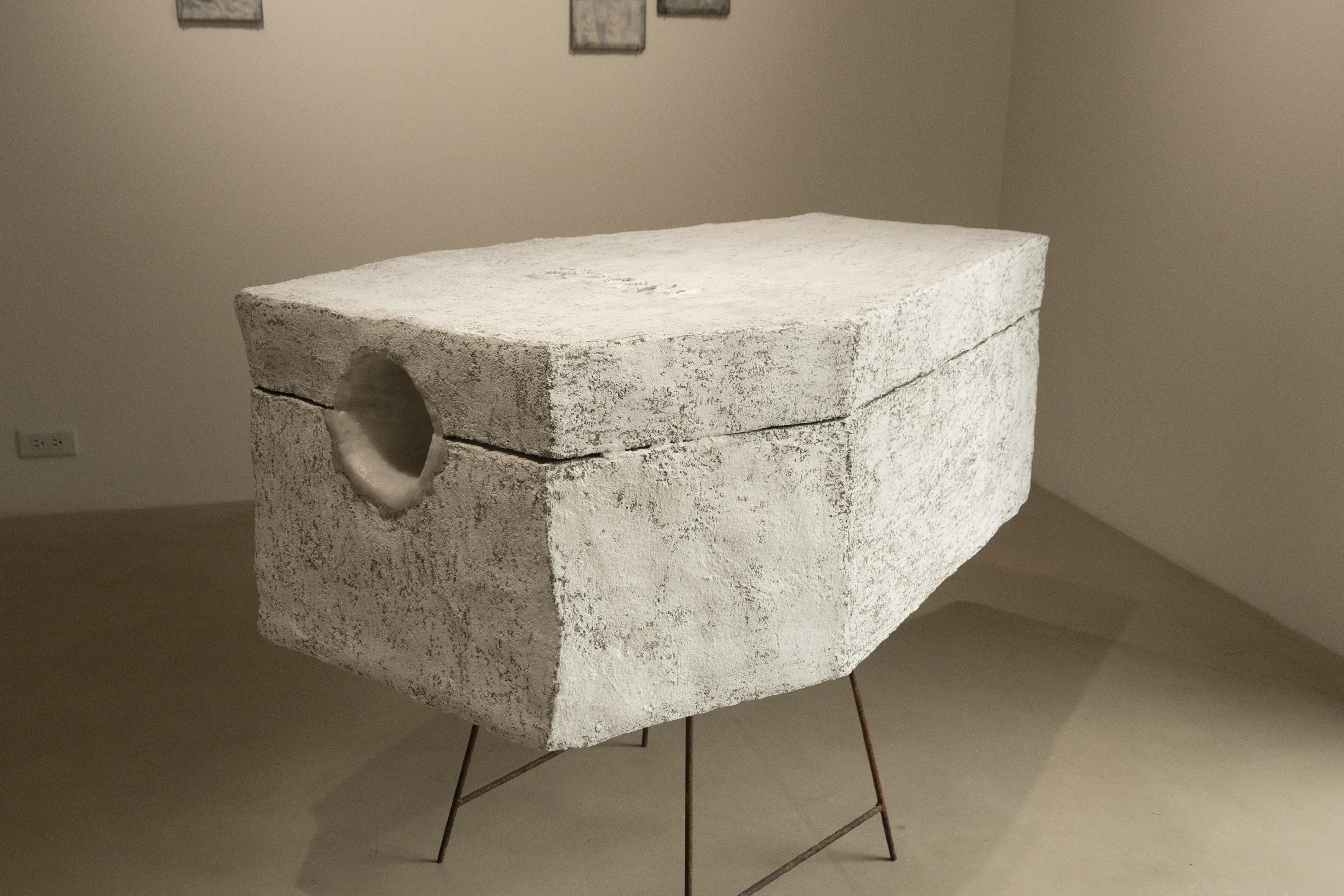 | 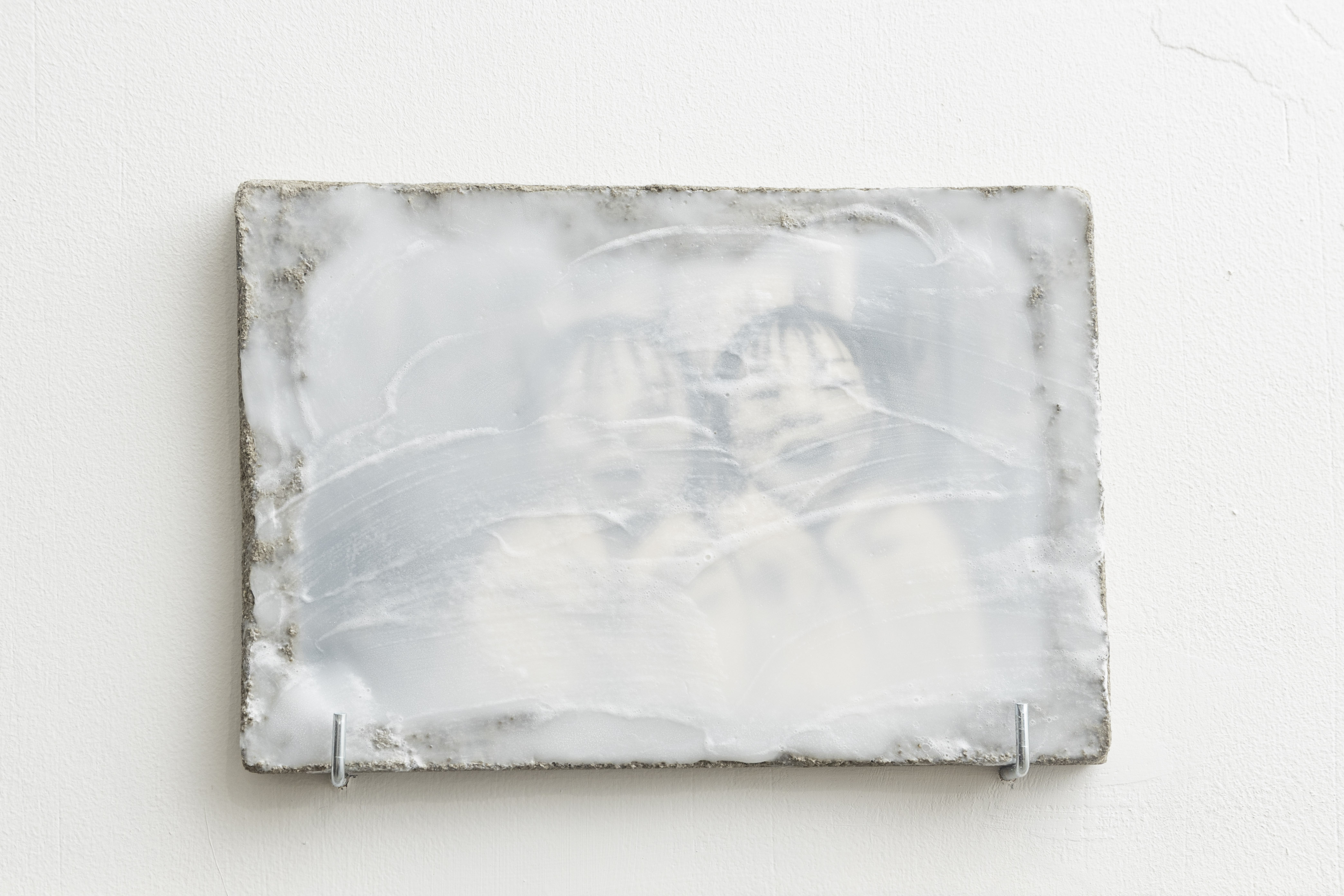 |
